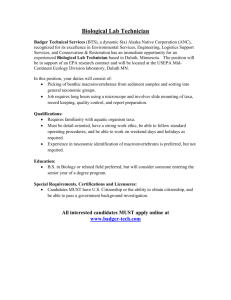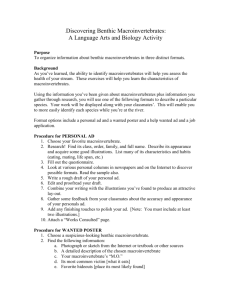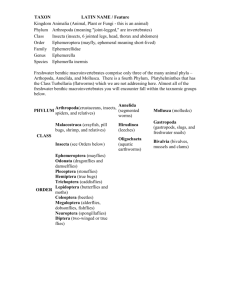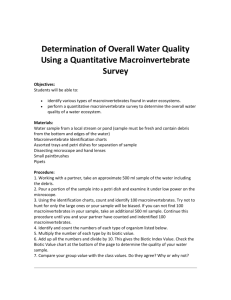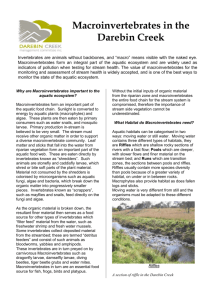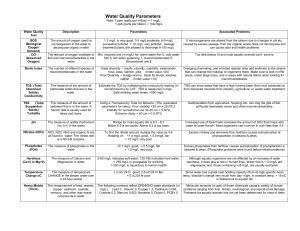Middle School Science Lesson Plans
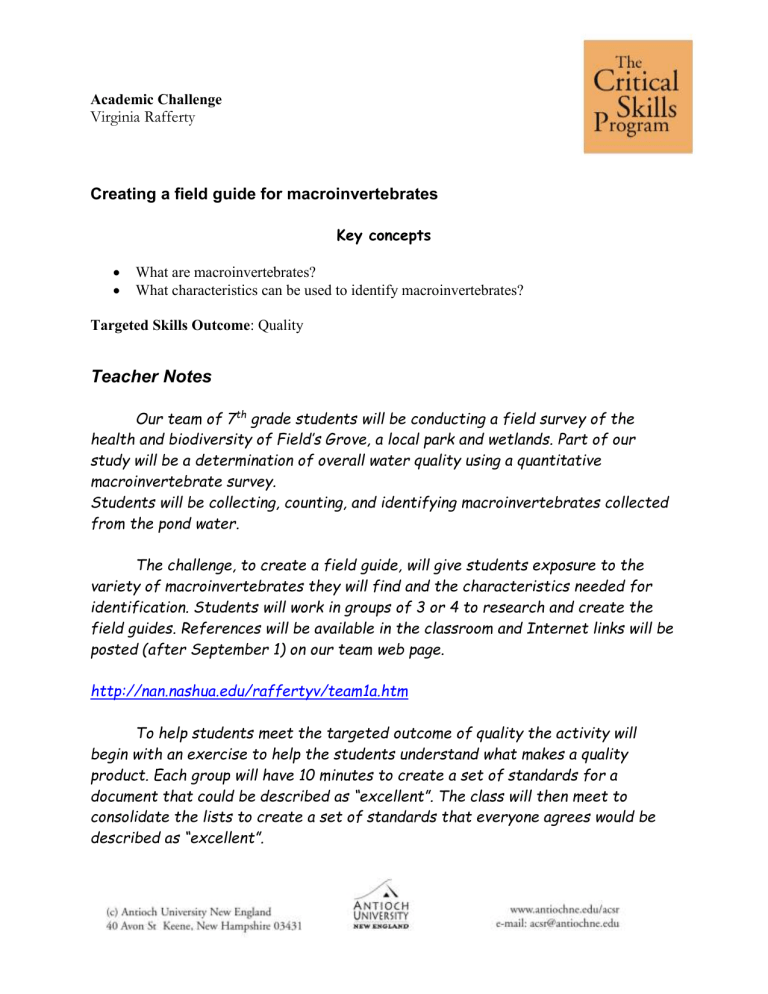
Academic Challenge
Virginia Rafferty
Creating a field guide for macroinvertebrates
Key concepts
What are macroinvertebrates?
What characteristics can be used to identify macroinvertebrates?
Targeted Skills Outcome : Quality
Teacher Notes
Our team of 7 th grade students will be conducting a field survey of the health and biodiversity of Field’s Grove, a local park and wetlands. Part of our study will be a determination of overall water quality using a quantitative macroinvertebrate survey.
Students will be collecting, counting, and identifying macroinvertebrates collected from the pond water.
The challenge, to create a field guide, will give students exposure to the variety of macroinvertebrates they will find and the characteristics needed for identification. Students will work in groups of 3 or 4 to research and create the field guides. References will be available in the classroom and Internet links will be posted (after September 1) on our team web page. http://nan.nashua.edu/raffertyv/team1a.htm
To help students meet the targeted outcome of quality the activity will begin with an exercise to help the students understand what makes a quality product. Each group will have 10 minutes to create a set of standards for a document that could be described as “excellent”. The class will then meet to consolidate the lists to create a set of standards that everyone agrees would be described as “excellent”.
Challenge:
Our team effort to determine if Field’s Grove is a healthy ecosystem will include a study of the macroinvertebrates found in the pond water at the park. We will be collecting, identifying, and counting macroinvertebrates. The data we collect can be used as an indicator of the health of the pond.
Macroinvertebrates are animals without backbones that are visible without the use of a microscope. Many organisms in a pond depend on the macroinvertebrates as a food source. A diversity of macroinvertebrates is necessary to support a healthy aquatic ecosystem. The type of macroinvertebrates that are present in a pond can also be used to indicate the quality of the water.
Some macroinvertebrates cannot survive in polluted water while others can survive or even thrive in polluted water.
Before our trip to Field’s Grove your group needs to be familiar with the characteristics that can be used to identify the macroinvertebrates you might collect. You will also need a reference guide to help in the identification process. To prepare for the trip your group needs to create a field guide that will assist you in the identification process. The field guide should contain labeled diagrams and descriptions of the organisms listed below.
MACRO INVERTEBRATES THAT MAY BE FOUND IN OUR POND
WATER.
Indicators of good water quality
Indicators of fair water quality
Indicators of poor water quality
Stonefly nymph
Mayfly nymph
Dobsonfly larva
Caddisfly lava
Riffle beetle
Water penny
Beetle larva
Sowbug
Scud
Clams, Mussels
Crayfish
Cranefly larva
Dragonfly nymph
Black fly larva
Midge fly larva
Snails
Leech
Aquatic worms
What will a quality Field Guide look like?
Before you begin your work, each group should create a set of standards that your group feels your work should meet to be described as “excellent”. In 10 minutes the class will meet to create together a set of standards that we all feel our work should meet to be described as
“excellent”.
Assessment
The scoring rubric will be used to assess the quality of the field guides A short quiz will also be used to evaluate individual understanding of the concepts.
Quiz questions:
1.
What are macroinvertebrates?
2.
Why are macroinvertebrates used as bioindicators of a healthy pond?
3.
Invent a macroinvertebrate. Make a labeled diagram of this invertebrate showing the characteristics that would be useful in identification. Write a brief description of your macroinvertebrate.
4.
List 4 characteristics could you use to identify this macroinvertebrate?
Scoring rubric (may be modified to reflect standards generated by the class)
1
Less than 9 of the
2
10 -12 of the
3
13 – 17 of the
4
All macroinvertebrates are included and identified
The diagrams are of poor quality/ some may be missing.
Descriptions are missing or are of poor quality. macroinvertebrates are included and identified
The diagrams are satisfactory but details are missing and some errors in anatomy may be present
Descriptions are included but important characteristics are not noted. macroinvertebrates are included and identified
The diagrams clearly show characteristics needed for classification
A description including major characteristics is included for each organism macroinvertebrates are included and identified
The diagrams are of exceptional quality and clearly labeled
Descriptions show a clear and exceptional understanding of the major characteristics
Little effort is apparent in organization and quality of the field guide
There is no cover or the cover is of very poor quality.
The organization and / or quality of the field guide needs work but some effort has been made.
The cover is missing a title, names of students,
Or shows limited effort or creativity
The field guide has a logical and easy to follow format and the overall quality is good.
The field guide has a cover that includes a title and the names of the students who created the guide
The field guide has a logical and easy to follow format and also shows exceptional effort and originality in design
The cover shows exceptional effort and originality
Total Points
Points
